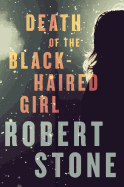I caught the bargain book fever during the late 1990s and loved the challenge of snap decisions based upon experience and instinct, as well as the biblio-highwire act of purchasing, in large quantities, nonreturnable books. I was a remainder/bargain book buyer for about six years and regularly bought from sales reps at the store or CIROBE and BEA (often in hotel suites before both shows); on wholesaler warehouse road trips; and, eventually, online. I merchandised my little heart out on the sales floor, monkeyed with pricing and watched monthly sales numbers like a bookie toting up wagers and calculating odds.
All of this was spinning through my mind when I attended the "Remainders and Bargain Books for Fun & Profit" education session at the NEIBA fall conference recently. The panel, which was moderated by Vicky Titcomb of Titcomb's Bookshop, East Sandwich, Mass., featured independent sales rep Ben Archer, whose blog--Ben Archer Books--covers the bargain world; Alie Hess of Brookline Booksmith, Brookline, Mass.; and Henry Zook of BookCourt, Brooklyn, N.Y.
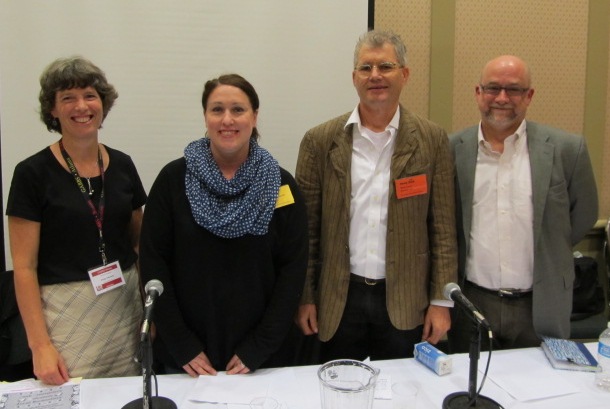 |
| Vicky Titcomb, Alie Hess, Henry Zook, Ben Archer |
"There's money to be made in remainders," said Titcomb, who admitted she took on the category reluctantly in 2012: "Our used books had slowed down and I gave the space to remainders. I'm the one who's here to say you can do this and it's huge fun." As with any store inventory, however, curating well is the key. "We only sell books because we're proud of them," she said. "If they're good books, they're going to sell."
Zook concurred, noting that while BookCourt did not originally sell remainders, the store began featuring them a few years ago and now he considers bargain books "a wonderful, fun part of the business." He still does the remainder buying himself. "One of the things that's enjoyable is that you don't know what you're going to see."
On the sales floor, BookCourt integrates remainders with new stock. "We find this works really well," Zook said. He also offered specific pointers: "It's a lot easier to sell remainders under $10 than over $10.... Any bookstore would do well with regional titles." When pricing books, "we assume that we're paying at least $1 freight per unit" and work that into the total retail cost, which can be easily manipulated: "There's a lot of freedom out there.... Don't sweat the shipping. Order what you need in the quantities you need."
How remainder stock is acquired was on everyone's mind and opinions varied. "I don't buy a lot of my remainders on the Web. I like to see what I'm buying," Zook said, recommending wholesaler warehouse visits in particular. "Each indie store is different. It's a great opportunity to find things there specifically for your store."
At Brookline Booksmith, the online option rules. "I spent a year or two buying without the Internet," said Hess. "I don't think I buy anything anymore that's not on a website." Bargain books account for about 10% the bookstore's annual sales, and are a regularly featured section in their weekly b-mail e-newsletter. "We have, at any given time of the year, four to eight remainder tables in different parts of the store," noted Hess, who is a frontlist and backlist buyer. "Remainder buying comes third, but it's awesome; so much fun.... Children's remainders are huge, if you can get the right stuff. I have to be very careful." She cited picture and activity books as particularly good performers.
Hess noted that location can be critical with bargain books. "A few years ago, it was decided to move them downstairs with used books," she recalled. The result was "devastating" and the stock was returned to its original location. "When they were gone, I think remainder customers stopped coming," she said. "It took a couple of years to get it back."
Archer, who started buying remainders more than 30 years ago for the Strand bookstore in New York City ("I was the first independent buyer that Fred Bass allowed to buy remainders."), now reps for several wholesalers. At the NEIBA panel, he began by saying he wanted to address in particular the "people who haven't got into bargain yet" and encourage them to do so.
He also offered some recommendations based upon his experience as a buyer and observations of other stores as a sales rep. Like Zook, Archer believes it is a "good idea to integrate spine-out," but to complement this with face-outs and stacks as well for "more impulse, more visual" sales. Where in the store should you feature remainders? Logic prevails. "If you have different areas that people never go to, don't set up there," he said. "You want to be well-positioned." On the other hand, "if you have a relatively under-performing section, think of making that mostly remainders and bargain to boost sales... then start adding frontlist gradually." As far as the buying itself is concerned, he cautioned against delegating that responsibility too soon: "If you're just starting out, buy yourself. And be sure to track inventory; some stuff runs out quickly, but other books can be reordered."
Titcomb agreed, noting that her "biggest mistakes are not ordering enough, but I love that mistake." And even though it can be "kind of a scary and overwhelming thing to get into remainders," she compared the buying process to a treasure hunt and advised indie booksellers: "If you're wondering about it, do it." --Robert Gray, contributing editor
 "I recall my excitement when Greenlight Bookstore opened in my old neighborhood of Fort Greene in Brooklyn. I was working as a freelance magazine writer at that time, and I was drawn to the Greenlight like a moth to the flame. I first began formulating my ideas for this book during the hours I spent in that bookstore."
"I recall my excitement when Greenlight Bookstore opened in my old neighborhood of Fort Greene in Brooklyn. I was working as a freelance magazine writer at that time, and I was drawn to the Greenlight like a moth to the flame. I first began formulating my ideas for this book during the hours I spent in that bookstore." 





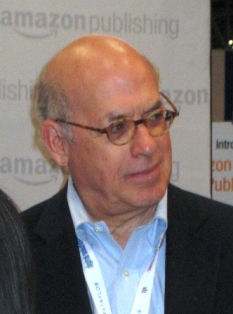 Big news concerning Amazon's attempt to become a major force in U.S. book publishing: Shelf Awareness has learned that Larry Kirshbaum, editorial head of the company's New York and Seattle adult imprints and children's publishing, is leaving the company early next year and returning to agenting. In connection with his departure, the most ambitious part of Amazon's publishing operations will be scaled back. Already several editorial people have left or been let go, and Amazon has not been a factor in bidding on major books the way it had been just two years ago.
Big news concerning Amazon's attempt to become a major force in U.S. book publishing: Shelf Awareness has learned that Larry Kirshbaum, editorial head of the company's New York and Seattle adult imprints and children's publishing, is leaving the company early next year and returning to agenting. In connection with his departure, the most ambitious part of Amazon's publishing operations will be scaled back. Already several editorial people have left or been let go, and Amazon has not been a factor in bidding on major books the way it had been just two years ago.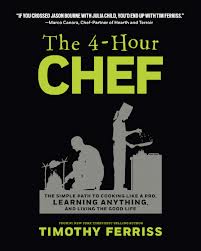 The first major Amazon titles to hit the market were My Mother Was Nuts by Penny Marshall, the film director, producer and actress, which appeared in September 2012, and The 4-Hour Chef: The Simple Path to Cooking Like a Pro, Learning Anything, and Living the Good Life by Timothy Ferriss, released in November 2012. Sales of Marshall's book were tepid for such a celebrity, and while Ferriss's book, bought for seven figures, did better, there were signs that the stand by B&N and most indies was having an effect--even if some observers thought they were being naive for not following "the wave of the future." (Besides chain and most indie booksellers, even Wal-Mart and Target declined to stock The 4-Hour Chef in-store.) Having some Amazon titles published in print versions by Houghton Mifflin Harcourt under the New Harvest imprint also did not help these big-name titles.
The first major Amazon titles to hit the market were My Mother Was Nuts by Penny Marshall, the film director, producer and actress, which appeared in September 2012, and The 4-Hour Chef: The Simple Path to Cooking Like a Pro, Learning Anything, and Living the Good Life by Timothy Ferriss, released in November 2012. Sales of Marshall's book were tepid for such a celebrity, and while Ferriss's book, bought for seven figures, did better, there were signs that the stand by B&N and most indies was having an effect--even if some observers thought they were being naive for not following "the wave of the future." (Besides chain and most indie booksellers, even Wal-Mart and Target declined to stock The 4-Hour Chef in-store.) Having some Amazon titles published in print versions by Houghton Mifflin Harcourt under the New Harvest imprint also did not help these big-name titles. In the third quarter ended September 30, Amazon net sales rose 24%, to $17.09 billion, more than analysts' average estimates of $16.8 billion, while the net loss was $41 million, what analysts expected.
In the third quarter ended September 30, Amazon net sales rose 24%, to $17.09 billion, more than analysts' average estimates of $16.8 billion, while the net loss was $41 million, what analysts expected.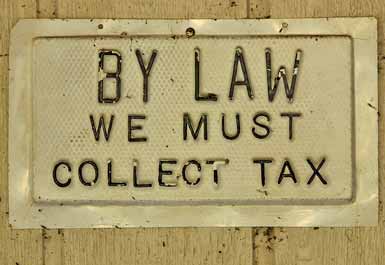 The announcement earlier this week that Amazon plans to build a new fulfillment center in
The announcement earlier this week that Amazon plans to build a new fulfillment center in 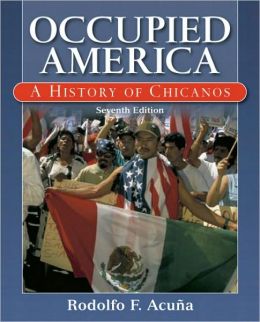 Seven books that were
Seven books that were  On Tuesday, November 26, the
On Tuesday, November 26, the 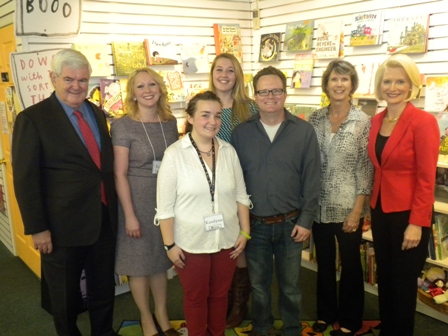 On Tuesday, Callista Gingrich (far r.) visited the Doylestown Bookshop, Doylestown, Pa., to promote her new children's book, Yankee Doodle Dandy (Regnery). Her husband, former Speaker of the House Newt Gingrich (far l.), was there as well, signing copies of his various books and talking about his forthcoming book, Breakout (Regnery, November). ABC and FOX News covered the event and the bookstore staff served bottled water, cheese and crackers to the many customers who queued in line to meet the couple and have their books autographed. Doylestown Bookshop staff between the Gingriches: publicist Krisy Paredes, supervisor Katelynn Hartley, bookseller Alayna Kennedy, bookseller Sean Curran and owner Glenda Childs.
On Tuesday, Callista Gingrich (far r.) visited the Doylestown Bookshop, Doylestown, Pa., to promote her new children's book, Yankee Doodle Dandy (Regnery). Her husband, former Speaker of the House Newt Gingrich (far l.), was there as well, signing copies of his various books and talking about his forthcoming book, Breakout (Regnery, November). ABC and FOX News covered the event and the bookstore staff served bottled water, cheese and crackers to the many customers who queued in line to meet the couple and have their books autographed. Doylestown Bookshop staff between the Gingriches: publicist Krisy Paredes, supervisor Katelynn Hartley, bookseller Alayna Kennedy, bookseller Sean Curran and owner Glenda Childs.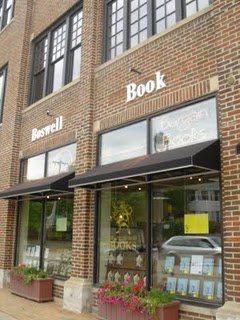 A piece called "
A piece called " Warriors: The Ultimate Guide
Warriors: The Ultimate Guide Candace (Fred Armisen) and Toni (Carrie Brownstein), the owners of
Candace (Fred Armisen) and Toni (Carrie Brownstein), the owners of  Fans of E.L. James's
Fans of E.L. James's 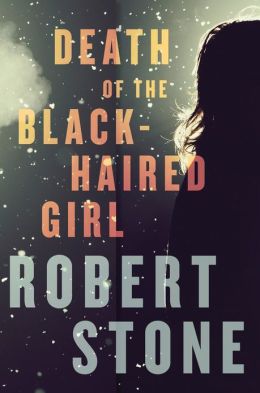 Robert Stone's fiction has consistently chronicled the troubled souls of this troubled world, from Vietnam (in the National Book Award-winning Dog Soldiers) to Jerusalem (Damascus Gate). Death of the Black-Haired Girl, only his seventh novel in nearly a 50-year career, is set in 2004 on a classic New England college campus, once a bucolic part of town, now a post-9/11 fortress. The novel's focus is beautiful, smart Maud Stack and her lover and professor, Steven Brookman. It's the oldest of stories: a middle-aged academic with a devoted wife obsessively falls for "youth, unquietness, intelligence, passion and lack of judgment." Maud's husky lust fuels his desire, but when Brookman's wife tells him she's pregnant again, he abruptly dismisses Maud, ending their affair with professorial rationalization: "She's here to grow up. She has to learn a few things, and one of them is that everything comes to an end."
Robert Stone's fiction has consistently chronicled the troubled souls of this troubled world, from Vietnam (in the National Book Award-winning Dog Soldiers) to Jerusalem (Damascus Gate). Death of the Black-Haired Girl, only his seventh novel in nearly a 50-year career, is set in 2004 on a classic New England college campus, once a bucolic part of town, now a post-9/11 fortress. The novel's focus is beautiful, smart Maud Stack and her lover and professor, Steven Brookman. It's the oldest of stories: a middle-aged academic with a devoted wife obsessively falls for "youth, unquietness, intelligence, passion and lack of judgment." Maud's husky lust fuels his desire, but when Brookman's wife tells him she's pregnant again, he abruptly dismisses Maud, ending their affair with professorial rationalization: "She's here to grow up. She has to learn a few things, and one of them is that everything comes to an end."